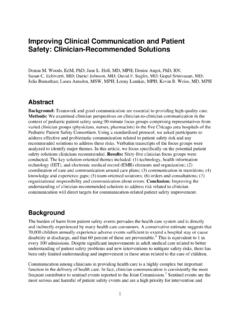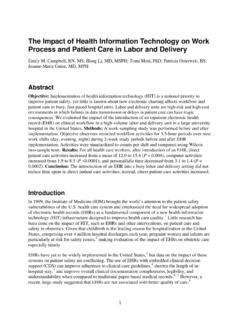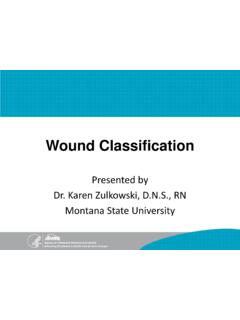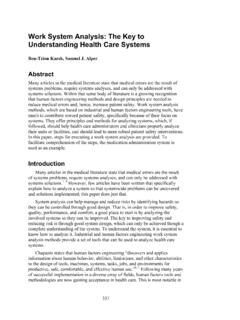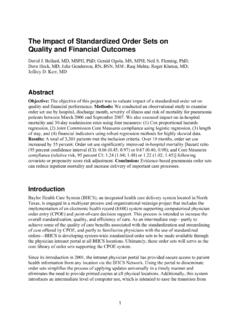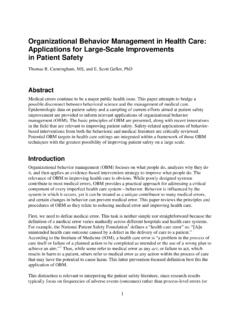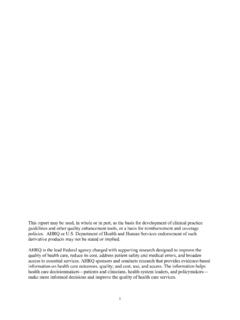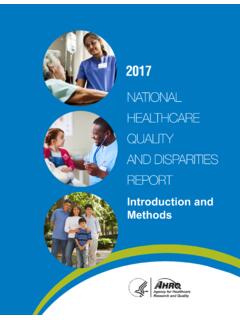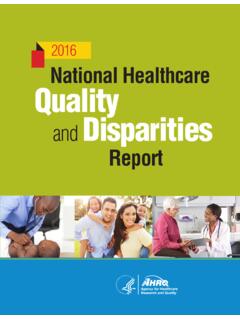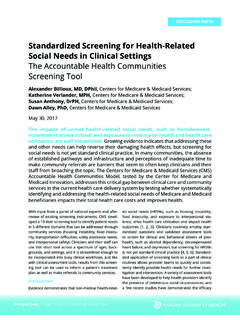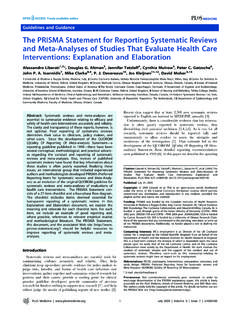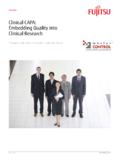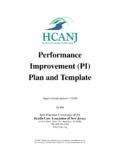Transcription of The Falls Management Program: A Quality Improvement ...
1 The Falls Management Program: A Quality Improvement Initiative for Nursing Facilities Authors: Jo A. Taylor, , Patricia Parmelee, Holly Brown, , Joseph Ouslander, Developed and supported by the Agency for Healthcare Research and Quality (AHRQ) #290-00-0011, Task Order No. 3 A program of Center for Health in Aging and the Emory University Division of Geriatric Medicine and Gerontology, Department of Medicine 1841 Clifton Road, Atlanta, Georgia, 30329 (404) 728-6900 October 2005 Acknowledgments We gratefully acknowledge the expert advice of Elizabeth Capezuti, , and Harry Strothers, and the invaluable work of Walton Harris in preparing the program materials. The Falls Management Program builds upon the previous work of Dr. Wayne Ray and colleagues at the Vanderbilt University School of Medicine.
2 Several components of the program and illustrations in this publication are used courtesy of the Depart-ment of Preventive Medicine in the Vanderbilt University School of Medicine. Lucy Rogers, Pam O Rourke, Ken Brouse and others at Ethica Healthcare Retirement Communities were instrumental in the development of the Tracking Record for Improving Patient Safety and have provided insightful feedback and assistance for material revisions. The information in this manual and the other program materials are intended to supplement the knowledge of nursing and medical staff. The instructions for altering the environment or adapting equipment as well as other care processes may not be applicable in your setting. Be-fore using any of the adaptations or items, all available information concerning the resident as well as particular circumstances of the environment and equipment must be carefully eval-uated by staff.
3 The information provided in this manual is advisory only and is not intended to replace sound clinical judgment or individualized resident care. Contents of this manual do not necessarily reflect CMS policy or endorsement. Table of Contents Chapter 1 Introduction and Program Overview 1 Chapter 2 Fall Response 9 Chapter 3 Data Collection and Analysis Using TRIPS 15 Chapter 4 Long-Term Management 20 Chapter 5 Information and Training for Staff, Primary Care Providers, and Residents and their Families 35 Chapter 6 Environment and Equipment Safety 49 Appendix A References and Equipment Sources Appendix B Forms and Training Materials Appendix C Case Study and Program Examples Appendix D Falls Engineer Instructions Introduction and Program Overview 1.
4 Program Goal and Background T he Falls Management Program (FMP) is an interdisciplinary Quality Improvement initiative. It is designed to assist nursing facilities in providing individualized, person-centered care, and im-proving their fall care processes and outcomes through educational and Quality Improvement tools. Why is this important? There are several reasons: Falls are common in nursing facilities. Of the million residents in nursing facilities, approximately half fall annually. About 1 in 3 of those who fall will fall two or more times in a year. Falls often have serious consequences, especially in frail older residents. Fall-related injuries decrease the resident s Quality of life and ability to function. Residents who fall without injury often de-velop a fear of falling that leads to self-imposed limitation of activity. One in every 10 residents who fall has a serious related injury and about 65,000 patients suffer a hip fracture each year.
5 Adverse con-sequences of Falls for residents are listed in Figure 1. Falls are a major safety concern for nursing facilities. Injuries resulting from Falls are a major reason for lawsuits against facilities and staff, which can result in the loss of large sums of money and higher insurance premiums. Potential consequences for facilities are listed in Figure 2. Many nursing facilities have fall programs in place, but recognize that there is always room for Improvement . While not all Falls and injuries can be prevented, it is critical to have a systematic process of assessment, intervention and monitoring that results in minimizing fall risk. 2. Causes of Falls The FMP helps facility staff to identify and intervene, whenever possible, on the common causes of Falls . Falls among nursing home residents are usually the consequence of a combination of risk fac-tors, both intrinsic and extrinsic.
6 Examples of these risk factors are illustrated in Figure 3. Key Points in Chapter 1 Background and causes of Falls in nursing homes FMP overview Building a culture of safety Developing the FMP team Figure 1 Adverse consequences of Falls for residents Reduced Quality of life Increased fear of falling and restriction of activities Decreased ability to function Serious injuries Increased risk of death Figure 2 Adverse consequences of Falls for nursing facilities Increased paperwork for staff Increased levels of care required for fallers Poor survey results Lawsuits High insurance premiums 1
7 Figure 3 Common fall risk factors Intrinsic factors Effects of aging on gait, balance and strength Acute medical conditions Chronic diseases Deconditioning from inactivity Behavioral symptoms and unsafe behaviors Medication side effects Extrinsic fall risk factors Environmental hazards Unsafe equipment Unsafe personal care items Figure 4 Examples of specific extrinsic risk factors Poor lighting Cluttered living space Uneven floors, wet areas Unstable furniture Unstable bed wheels Ineffective wheelchair brakes Missing equipment parts Improper footwear Hard-to-manage clothing Inaccessible personal items Introduction and Program Overview Although intrinsic risk factors such as age-related changes and chron-ic diseases cannot be eliminated, they can be managed in a way to reduce the resident s risk of falling.
8 Medical Management of both acute and chronic conditions can be improved through appropriate evaluation and treatment. Extrinsic risk factors can also be addressed to improve safety in the environment and during equipment use. Figure 4 gives examples of specific extrinsic risk factors which can be modified by staff to decrease risk. The FMP is designed to assist facilities in addressing both intrinsic and extrinsic risk factors. It is important to remember that not all Falls can be prevented. Nonetheless, research shows that a facility s fall rate can be substantially reduced by using a multifaceted approach that includes comprehensive Falls assessment and individualized care planning by an interdisciplinary team, organizational support and appropriate Management using Quality Improvement methods. 3. Overview of the Falls Management Program The FMP includes two primary approaches to the Management of Falls and injuries.
9 The first is through an immediate response to residents who fall. When a fall occurs, careful evaluation and in-vestigation, along with immediate intervention during the first 24 hours, can help identify risk and prevent future incidents. The second approach is long-term Management . Here, screening at admission, quarterly, annually and change of condition are key in identifying residents at high risk of a fall. In both approaches, a comprehensive Falls assessment should be used to develop individualized care plan interventions. Staff should monitor and manage the resident s re-sponse, making care plan revisions as both approaches are fundamental to a comprehensive program, the burden on staff in terms of increased time and paperwork due to the high number of resident Falls is significant. Facilities that master the fall response process can shift from crisis Management to proactive reduction of fall risk and related injuries.
10 4. Culture of Safety The term culture of safety is used to describe how the behavior of staff and Management affects the safety of residents. The development of a culture of safety is an important first step to ensure that the FMP is effective and integrated into the organizational system. 2 Introduction and Program Overview Developing a culture of safety requires changes in staff attitudes, beliefs and behavior as well as changes in Management style. This change process requires strong leadership, effective communica-tion, new policy development and the formation of multidisciplinary teams to address areas for Improvement .
